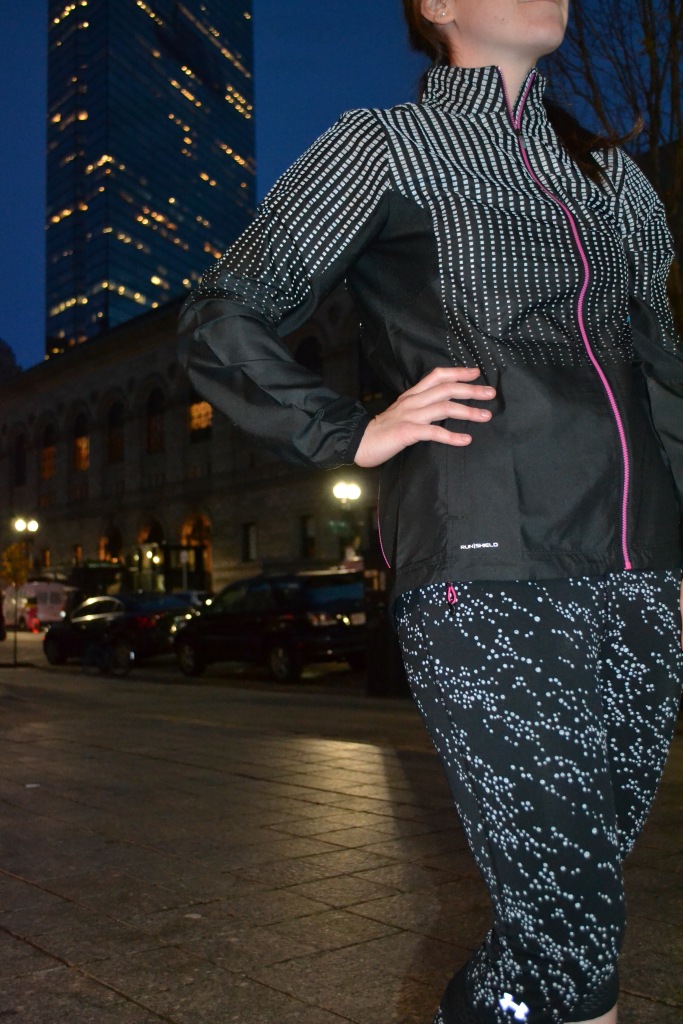Winter is HERE baby! So the time for a good running jacket is now. For the most part, you can get by without graduating to a shell outer layer through the fall and early winter. But for days like we’ve had recently, where the wind is whipping and windchills are in the single digits, a good jacket can make the difference between getting back from your run and saying ‘man, I feel good!’ or ‘man, I think I have pneumonia.’

So let’s get down to the nuts and bolts of what makes a good running jacket. First, we have to talk about fabric types. While your baselayer and midlayers are made from a knit fabric (giving them stretch in all directions and a snug fit), your outer layer is typically constructed with a woven fabric. Wovens have very little stretch, keep their shape well, and are significantly more durable than knits. That extra durability and the added features in running jackets explain the higher price point. You’ll pay a little more, but you’re investing in a piece you’ll use for years.

So, first step in choosing the right running jacket – make sure it fits and can accommodate inner layers. Since the woven fabric of the jacket means it doesn’t stretch much, you’re looking for a slightly looser, boxier fit. Raise your hands over your head – if the jacket feels too tight when you do that, try going up a size. We’re going for full range of motion so you will be comfortable during your run.
Next – look for things like reflectivity and pockets. Chances are, you’ll be doing at least some running in darkness (whether in the morning or evening) and reflectivity is key for runner safety. And pockets are always a plus!
Finally – think about the conditions you’ll likely be running in. Do you tend to stay in when its raining or snowing but will gladly go out when its 10* and clear? Then look for something with more of a focus on warmth and wind resistance rather than a ton of water resistance. Love running in the rain and snow? Then you’re looking for something with a lot of water resistance and maybe not so much warmth. Running all winter, no matter the weather? Now we’re talking!
So let’s highlight a few of our favorite jackets:
ASICS STORM SHELTER $130
 KEY FEATURES: Seam-sealed, meaning fully waterproof. Has zippered body vents for breathability. 360* 3M reflectivity; removable hood. A versatile option – works as a good everyday raincoat as well!
KEY FEATURES: Seam-sealed, meaning fully waterproof. Has zippered body vents for breathability. 360* 3M reflectivity; removable hood. A versatile option – works as a good everyday raincoat as well!
WEAR THIS DURING: Rain or snow, any sort of wet precipitation. This is one of the only truly waterproof jackets we sell. Full reflectivity make this a safe choice for nighttime runners.
SAUCONY SONIC REFLEX $135
 KEY FEATURES: The most reflectivity of the bunch, with full chest and back coverage. Vented panels under arms for breathability, and a bit of stretch.
KEY FEATURES: The most reflectivity of the bunch, with full chest and back coverage. Vented panels under arms for breathability, and a bit of stretch.
WEAR THIS DURING: Chilly but clear runs. An especially good choice for after-work runners due to high degree of reflectivity. Relatively lightweight compared to the others – ideal for a runner that heats up very quickly or sweats a lot.
NIKE SHIELD FULL ZIP $110
 KEY FEATURES: DWR coated for water repellancy. Stretch panels throughout to give a little more movement. Poly-lined inside for extra warmth, and foldover mitts. The key part of this soft shell is the fleecy lining, which makes this the warmest option of the bunch.
KEY FEATURES: DWR coated for water repellancy. Stretch panels throughout to give a little more movement. Poly-lined inside for extra warmth, and foldover mitts. The key part of this soft shell is the fleecy lining, which makes this the warmest option of the bunch.
WEAR THIS DURING: Bitter cold but clear days. This doesn’t have as much wind resistance as other pieces but is super warm, thanks to the polyester lining.
THE NORTH FACE ISOTHERM $160
 KEY FEATURES: Windstopper fabric protects you during the windchilliest (is that a word?) of days. FlashDry fabric moves moisture while trapping body heat. A bit of reflectivity with zipper piping.
KEY FEATURES: Windstopper fabric protects you during the windchilliest (is that a word?) of days. FlashDry fabric moves moisture while trapping body heat. A bit of reflectivity with zipper piping.
WEAR THIS DURING: You know those days where the wind and whipping and you can’t feel your face? Wear the Isotherm on those days. This is probably the best option in terms of combining warmth, wind resistance, and reflectivity.
